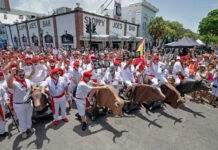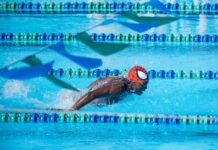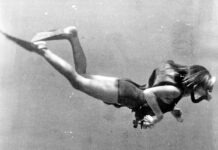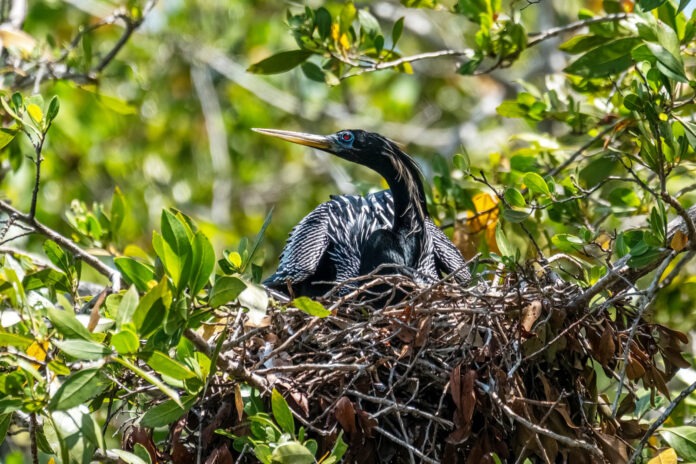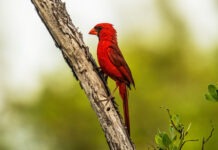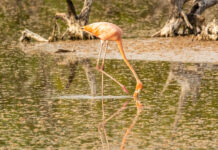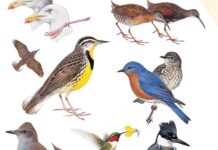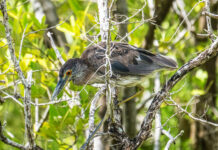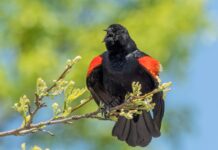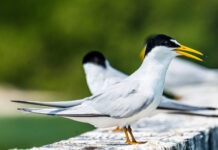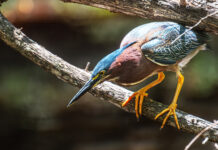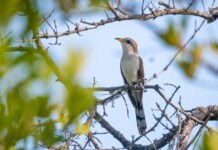The thing I like most about anhingas is their long pointy bill. It’s somewhat stabby looking, possibly because it is built for stabbing.
Non-birders, and neo-birders often confuse anhingas with double-creasted cormorants because of their similar sizes, shape and habits. Both species are dark and hold their wings out in an, “Are you not entertained?” manner. Both spend their lives in, or at the edge of, the water. Both species feed by swimming around underwater and catching fish. Neither species is a particularly gainly walker.
The bill is the easiest cheat to distinguish one from the other. Cormorants, which clench prey in their mouths, have a hooked bill, which makes it easier to keep a grip on a slippery fish. Anhingas have a long, dagger-like bill to stab their prey, usually with their mouth slightly open. It’s an action that isn’t so much like stabbing a fish with a knife as stabbing a fish with a sharpened pair of chopsticks, or with a pair of slightly open scissors.
They do have a couple serrations on the tip of their bill to keep the fish from sliding off.
Once they have secured the fish they will usually hop up to a perch over the water, a perch that may be habitual for them. Then, like some dime store hustler flipping a coin, they throw the fish up into the air, catch it in their gullet, and gulp it down.
On average they will fish for three-and-a-half hours a day, catching one fish for every five minutes of hunting.
The anhinga’s bill tapers almost perfectly into its head and neck, creating something that looks like a long, feathered spike when extended. The skull is so skinny it’s hard to believe it contains enough gray matter to control all the bird’s parts. For a while I wondered if the brain was somehow elongated, but looking at photos of anhinga skulls, no. The skull behind the bill is very compact, almost bulbous. It creates a small bump, but it’s easier to find if you look for the eyes.
Anhingas have an S-shaped kink in the upper part of their neck that allows them to essentially cock their head back and jab without losing sight of their target.
Unlike cormorants, you will occasionally see anhingas riding on thermals. I have seen them so high up that their skinny head and neck become nearly invisible compared to the relative bulk of the rest of their body. A couple times a year, on a consistent if irregular basis, I will see one like that and, because of its long pointy wings, confuse it with a peregrine falcon for half a second, followed by 40 seconds of self-recrimination about how many times I’m going to fall for that.
Some of the older names for anhingas were water-turkeys, as their tails do look turkey-like, and snake-birds, because they had a tendency to paddle around with only their head above water. The name anhinga comes from the language of the Tupi people in Brazil and translates to devil bird, which seems a bit harsh, as the species don’t do much but mind their own business. They tend only to show ill will toward, well, the fish they eat, but also males of their own species who get too close to other males’ nesting locations.
Anhingas are one of the few birds we have in North America who name is a mononym sans any kind of descriptor. The scientific name for the species is anhinga anhinga, and there are four subspecies. The one we have here in the warm water parts of the U.S. is anhinga anhinga leucogaster. The exact meaning of leucogaster is hard to track down. But it doesn’t matter, because it is just a jealousy-inducing disappointment compared to the name of the subspecies found in most of South America — anhinga anhinga anhinga, which sounds a bit like a Beetlejuician summons.
Anhingas are one of the more common and more visible birds in Florida. Anhingas’ bones are less hollow than those of other birds, and their feathers absorb water, allowing them to sink more easily below the surface. But it also requires them to spend periods of time with their wings spread out both to dry them and to thermoregulate, which also adds to their visibility.
Anhingas are a partially migratory species, meaning not that they partially migrate, but that birds in some parts of their range – generally the more northerly parts – migrate, and birds in other parts don’t. The Florida population is thought to be non-migratory, though I did look out the window once at my old space at the Armory to see a flock of 150 or so, all circling in unison over the tin roofs of the city, like some airborne gang of synchronized swimmers. So what were they doing flying around like that if they weren’t migrating?
The general take on anhingas is that they are a freshwater species. But it is probably less about the salinity of the water than its depth and volatility. They prefer to hunt in shallower, calmer habitats. Also, they need a proper perch, and those are more likely found near lakes and rivers.
While we don’t have a lot of freshwater in the Lower Keys – just a few borrow pits with freshwater lenses – we do have a small population of anhingas. Generally I see them at random, maybe nesting at Indigenous Park or the golf course. For a couple years I was seeing them consistently flying over an island off the Boca Chica Bridge, but I have not seen them there of late.
If you live in the Keys and by some freak of fate have never seen an anhinga, there’s an easy way to cure that. At least three nests are active right now at the Blue Hole on Big Pine.
I spent some time watching them from the platform the other morning. Closest to the nest was a male, eyes encircled in blue, serenely sitting on eggs that had yet to hatch. Farthest away was a nest with no adults and three pale white nestlings, covered in down, waiting to be fed.
I waited a while. Several groups of out-of-town visitors came and went. The refuge volunteers had a spotting scope on a tripod aimed at the nest with the chicks, and tried to clue the visitors in to some of the goings on at the pond.
I grew impatient, calmed myself, then got impatient again.
Finally the father returned, and a mob scene ensued – three chicks trying to feed themselves out of one gullet. The frenzy probably lasted a minute. Then he was out of food and the chicks calmed down. He hopped over to another branch and stared at the pond below.
None of it seemed very demonic.


